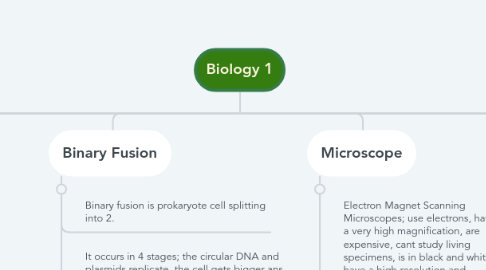Biology 1
by Amy Tann

1. Cells
1.1. Bacteria cells contain; a cell membrane, a cell wall, cytoplasm, a strand of DNA and sometimes plasmids.
1.2. Plant cells contain; a nucleus, cytoplasm, a cell membrane, mitrocondria, ribosomes, a cell wall, a vacuole and chloroplasts.
1.3. Eukaryotes are plant and animal cells.
1.4. Animal cells contain; a nucleus, cytoplasm, a cell membrane, mitochondria and ribosomes.
1.5. Prokaryotes are bacteria cells.
2. Cell Specialization
2.1. Specialized cells include; sperm cells, nerve cells, phloem, xylem, muscle cells and root hair cells.
2.2. Sperm cells have adapted by; having a flagellum allowing it to move to fertilize the egg, having more mitochondria to power the flagellum, it has an acrosome to penetrate the egg.
2.3. Nerve cells have adapted by; it has a long axon so it can deliver an action a long way, it has synapses so messages can only travel in one direction.
2.4. Phloem has sieve plates to filter out unwanted substances.
2.5. Xylem has no end walls between the cells so water and minerals can flow freely.
2.6. Muscle cells have adapted by; has lots of unique protein molecules that interlock.
2.7. Specialized cells are cells that have adapted and changed to do a specific job.
3. Chromosomes and Mitosis
3.1. Chromosomes contain genetic information.
3.2. The cell cycle occurs before Mitosis.
3.3. Growth and DNA replication is carried out in 2 stages; the cell grows and increases the amount of subcellular structures (mitochondria,ribosomes)and then it duplicates its DNA so there is 1 copy for each new cell.
3.4. Mitosis is the process of cell replication by division.
3.5. Mitosis is carried out in 3 stages; the chromosomes line up and the cell fibres pull them apart, membranes form around each of the sets these become the nuclei of the new cells, the cytoplasm and cell membrane divide.
4. Binary Fusion
4.1. Binary fusion is prokaryote cell splitting into 2.
4.2. It occurs in 4 stages; the circular DNA and plasmids replicate, the cell gets bigger ans the DNA moves to opposite ends, the cytoplasm begins to divide and the new cell wall begins to form, the cytoplasm divides and 2 daughter cells are produced.
5. Stem Cells
5.1. There are two types of stem cells; adult stem cells and embryonic stem cells.
5.2. Adult stem cells are unspecialized cells that can develop into many types of cells.
5.3. Embryonic stem cells are unsepecialized cells that can turn into any cells.
5.4. Totipotent cells can form all cell types. Embryonic cells within the first couple of splits are the only cells that are totipotent.
5.5. Pluripotent can give rise to all cell types.
5.6. Multipotent can develop into more than one type of cell but are more restricted than pluripotent cells.
6. Diffusion and Osmosis
6.1. Diffusion is the spreading out of particles from an area of higher concentration to an area of lower concentration.
6.2. Diffusion happens in solids and liquids.
6.3. The bigger the concentration gradient, the faster the diffusion rate.
6.4. Higher temperature causes a high diffusion rate.
6.5. Osmosis is the movement of WATER and WATER ONLY.
6.6. Osmosis is a type of diffusion that occurs across a semi-permeable membrane without the use of energy.
6.7. Water moves to high solute concentration.
6.8. Hypertonic is a higher concentration of solutes. Hypotonic is the lower concentration of solutes. Isotonic is equal concentration.
7. Active Transport
7.1. Active transport is the movement of molecules up a concentration gradient using energy from the break down of ATP.
7.2. Active transport is used in the gut when there is a lower concentration of nutrients in the gut, but a higher concentration of nutrients in the blood. this means glucose can be taken into the bloodstream, where it is used for respiration.
8. Microscope
8.1. Electron Magnet Scanning Microscopes; use electrons, have a very high magnification, are expensive, cant study living specimens, is in black and white, have a high resolution and require training to use.
8.2. Light Microscopes; uses photons, you can see colour, you can see living cells and have a 1000 to 2000 times magnification.
8.3. Magnification= Size of Image/ Size of Object


